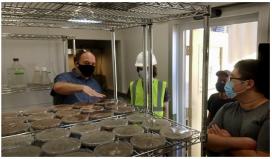Center Develops Procedure to Biologically Restore the Crust Cover of Degraded Soils
The Center for Bio-mediated and Bio-inspired Geotechnics (CBBG), an NSF-funded Engineering Research Center (ERC) headquartered at Arizona State University, developed a procedure to enrich and scale microbial topsoil communities, known as biocrust, which can be used to restore the degraded soil of semi-arid and arid lands.
Degraded biocrust results in erosion and particulates known as fugitive dust, which lower air quality and present a significant health risk to local populations. The Center’s procedure to scale the growth of biocrust microbial communities shows promise as a sustainable method for restoring biocrust and mitigating the dust.
Fugitive dust is comprised of small particulate matter that is suspended in the air, primarily from soil that has been disturbed by wind or other activities. The small particulates can be easily inhaled, causing respiratory illness, lung damage, and even premature death to individuals whose health may be compromised.
Microbial topsoil communities (biocrusts) naturally mitigate erosion and fugitive dust. The methods developed by the CBBG team show promise for long-term, scalable soil-stabilization measures that offer significant mitigation of erosion and fugitive dust.



